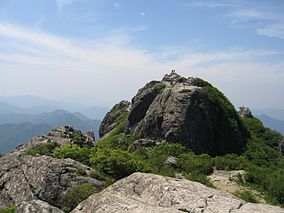Gayasan National Park
| 가야산국립공원, 伽倻山國立公園 | |
|---|---|
| Gaya Mountain National Park | |
 Sanghwang peak, 2004. | |
| Nearest city | Daegu, South Korea |
| Coordinates | 35°49′N 128°07′E / 35.817°N 128.117°E |
| Area | 64.71 sq mi (167.6 km2)[1] |
| Established | 13 October 1972[1] |
| Governing body | Korea National Park Service |
Land-based parks are in red and marine parks are in blue.
| Gayasan National Park | |
| Hangul | 가야산 국립공원 |
|---|---|
| Hanja | 伽倻山 國立公園 |
| Revised Romanization | Gayasan Gungnip Gongwon |
| McCune–Reischauer | Kayasan Kungnip Kongwŏn |
Gayasan National Park, also known as Gaya Mountain National Park (Korean: 가야산국립공원), is a large national park in the eastern part of South Korea. The park is named in honor of Gaya Mountain and became a National Park in 1972.[2]
The park includes Haeinsa, which is one of the main temples of the Jogye Order of Korean Buddhism.[3]
Geography
[edit]Gayasan National Park covers an area of more than 160 square kilometers. The national park extends from the northern edge of South Gyeongsang Province, to the southern limit of North Gyeongsang Province. The Sobaek Mountain range runs through this area.
Gaya Mountain
[edit]The national park is named in honor of Gaya Mountain. This mountain has two major peaks: one of them is Sangwangbong Peak, for which the height is 1,430 meters, and the other slightly higher peak, Chulbulbong, is 1,433 above sea level.
Special features
[edit]
One significant feature of the national park is Haeinsa. This Buddhist temple includes in its grounds a standing Buddha figure carved into a vertical rock.
Another feature of the park is Yongmun Falls and Hongnyudong Valley. 380 different species of plant have been identified as growing there, as well as 100 species of birds, and other wild animals.
History
[edit]The area was declared scenic site number 5 by the Korean government in 1966, and it became an official National Park in 1972.
The remoteness of the area has played a role in protecting it from destruction in the past, specifically during the Japanese invasions of 1592-98, when much of the country was razed.
Since that time, legend says that the area around Gaya Mountains is free from the Three Disasters: fire, floods and wind.
Gallery
[edit]-
Gayasan from Haeinsa temple
-
Gayasan from Southeast
-
Ruins of Baekumam temple in Gayasan
-
Gayasan Castle in Gayasan
-
Stone walls near Chilbulbong Peak in Gayasan (1)
-
Stone walls near Chilbulbong Peak in Gayasan (2)
-
Sangwangbong Peak of Gayasan
-
Rituals of Buddhism in Gayasan
Recreation
[edit]Gayasan National Park has multiple hiking trails that run through the mountainous park.[4] The most trafficked trail begins in Heinsa Temple and contains a guard station that provides park information for visitors.
There are three designated campgrounds within the borders of the park for day use and overnight tent camping.[4]
References
[edit]- ^ a b "Gayasan: Intro". Korea National Park Service. Archived from the original on 21 September 2010. Retrieved 18 September 2010.
- ^ "Gayasan National Park (Hongnyudong, Cheongnyangdong Area) (가야산국립공원-홍류동,청량동지구)". english.visitkorea.or.kr. Retrieved 2020-07-08.
- ^ "Jogye Order Temples | Welcome to Jogye Order of Korean Buddhism". koreanbuddhism.net. Archived from the original on 2021-09-21. Retrieved 2020-07-08.
- ^ a b "Korea National Park". english.knps.or.kr. Archived from the original on 2010-09-21. Retrieved 2020-07-08.
External links
[edit]- The park's page on Korea National Park Service's website Archived 2010-09-21 at the Wayback Machine
 Gayasan Mountain National Park travel guide from Wikivoyage
Gayasan Mountain National Park travel guide from Wikivoyage- Korea in the Clouds: A Detailed Guide to Hiking Korea's Mountains
- Printable Trailmap of Gayasan (from Korea in the Clouds)[permanent dead link]









